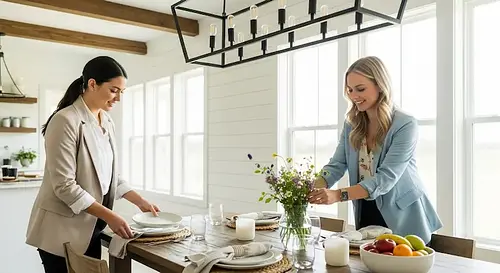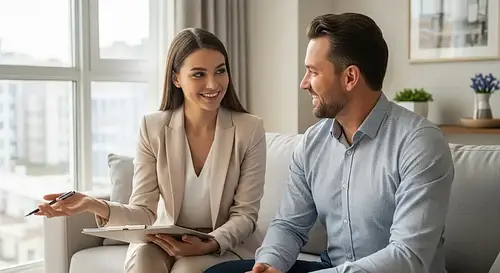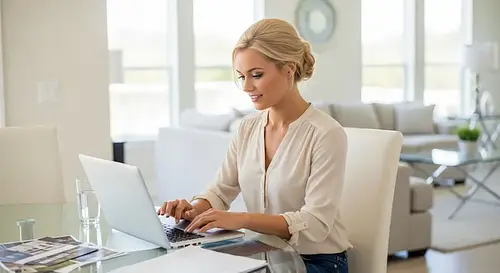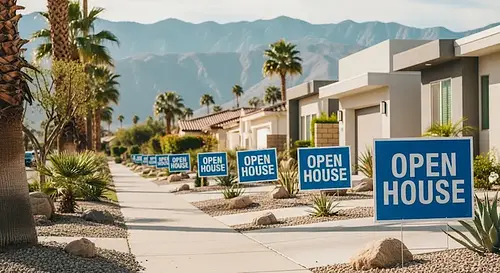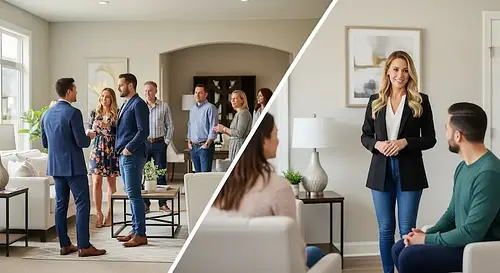Open House Setup Ideas No One Will Tell You
Want more traffic, better leads, and a faster sale? It all starts with how you set up your open house. In this guide, we’ll share the most effective open house setup ideas to help you attract more buyers, showcase the home’s best features, and generate high-quality leads. Whether you’re prepping the curb appeal, staging the living room, or setting up a sign-in station, these expert tips will help you make every showing count.

Written by Seth Cox
Jul 04, 2025 / Open house marketing
In today’s competitive market, you need more than a tidy entryway and a batch of cookies. You need an open house strategy. From how the home looks and feels, to how you capture contact information and follow up afterward, every detail of your setup plays a role in the success of the event. The goal is simple: attract the right buyers, make a lasting impression, and generate high-quality leads that move you closer to a sale.
In this article, we’ll walk through the most effective open house setup ideas that real estate agents can use to improve results. You’ll learn:
- How to enhance curb appeal and create a strong first impression
- Interior setup and staging techniques that highlight the home’s best features
- Ideas for creating a welcoming, memorable atmosphere
- Smart ways to set up lead capture and follow-up systems
- Creative tips to make your open house stand out from others in the neighborhood
Whether you're a new agent trying to build momentum or a seasoned pro looking to fine-tune your process, these actionable tips will help you set the stage for a successful open house.
Related: Open House Checklist for Agents

Eye-Catching Curb Appeal: Outdoor Open House Setup Ideas
Boost Curb Appeal Before the Open House Begins
Here’s where to focus:
- Mow the lawn and trim overgrown bushes or trees
- Power wash walkways, driveways, and front steps
- Add fresh mulch or seasonal flowers to brighten up garden beds
- Clear away clutter like hoses, toys, or yard signs
Set Up Open House Signs That Grab Attention
For best results:
- Place 4–6 branded signs at nearby intersections and entry points
- Use arrows to guide traffic from major roads into the neighborhood
- Make sure all signs are clean, sturdy, and consistently branded
- Add balloons or feather flags for extra visibility (if allowed)
Create a Front Porch Setup That Feels Welcoming
Try adding:
- A fresh welcome mat
- A tasteful wreath or potted plant near the door
- Soft music playing from inside to create ambiance
- A neutral, pleasant scent—like citrus or fresh linen (avoid anything overpowering)

Interior Open House Setup Ideas That Inspire
Highlight the Home’s Strengths Through Staging and Flow
Here’s what to focus on:
- Declutter surfaces, shelves, and corners to create a sense of space
- Define areas clearly—use rugs, lighting, or art to give each zone a purpose
- Remove unnecessary furniture to improve flow and highlight square footage
- Keep the layout intuitive so buyers never wonder where to go next
Use Lighting and Scent to Set the Right Mood
Try this setup:
- Open windows slightly if weather allows to keep air fresh
- Use consistent, warm lighting in every room
- Choose one subtle scent for the whole house—nothing overpowering
Style the Home to Feel Move-In Ready
Interior open house setup isn’t about overdoing it—it’s about making every room feel intentional. With the right layout, lighting, and details, you’ll create an experience that helps buyers picture themselves living there.

Open House Staging and Layout Setup
Focus on the Features That Sell Homes
Staging priorities might include:
- Pulling back curtains to showcase large windows or views
- Removing rugs that hide beautiful flooring
- Using furniture to frame (not crowd) architectural highlights like fireplaces or beams
- Placing accent lighting near standout details like built-ins or tilework
Keep the Layout Simple and Intuitive
Key layout strategies:
- Leave wide walking paths between furniture and doorways
- Minimize visual noise—too many decor items can make rooms feel smaller
- Anchor floating furniture with rugs or side tables to create cohesion
- Stage each room with only one purpose (e.g., no guest room/home office hybrids)
Add Just Enough Warmth to Spark Emotion
You’re not decorating—you’re storytelling. The right layout and staging work together to make the home feel open, balanced, and aspirational. When setup is done well, buyers don’t just admire the space—they start mentally moving in.

Creating a Comfortable and Inviting Atmosphere at Your Open House
See more: What to bring to an open house as a realtor
Set the Temperature Before Guests Arrive
Ideal comfort tips:
- Keep the thermostat between 68–72°F
- Close windows if it’s noisy outside or the air is too humid
- Consider a fan or portable heater if the home has uneven airflow
Use Music and Scent to Influence Mood
Here’s a reliable formula:
- Instrumental or jazz music playing softly from a Bluetooth speaker
- A single scent throughout the home (citrus, linen, or mild lavender work well)
- Open windows slightly—if conditions allow—to bring in fresh air
Offer Refreshments Without Creating Distractions
Smart refreshment setup:
- Choose a single surface—like a kitchen island or console table
- Include branded napkins or business cards nearby
- Keep everything tidy and allergen-conscious (no nuts, no messy sauces)
When buyers feel physically comfortable and emotionally at ease, they stay longer—and that gives you more time to build a connection and earn their interest.

Digital Open House Sign In Sheet To Collect Leads
The best open house setup ideas don’t stop at visual appeal—they include tools and strategies that turn foot traffic into future business.
Make Sign-In Easy, Fast, and Digital
Use a tool like Showable’s digital sign-in to:
- Capture names, emails, and phone numbers in real time
- Automatically tag leads with property info
- Trigger instant follow-up sequences via your CRM
- Offer a smoother, modern experience for guests
Offer a Giveaway to Boost Engagement
Best practices:
- Display the prize near the sign-in station
- Keep the value modest but appealing
- Mention the giveaway during your greeting
Prepare Your Follow-Up Plan Before the Doors Open
A basic follow-up setup might include:
- Immediate text or email within 24 hours
- A second message with a property flyer, disclosures, or comp sheet
- A final message asking if they’d like to schedule a private showing
Lead capture doesn’t have to be pushy—it just has to be planned. When done right, it turns casual visitors into serious prospects, and serious prospects into clients.

Creative Open House Setup Ideas to Make Your Event Stand Out
Add a Theme That Fits the Property or Season
Some easy-to-execute ideas:
- Serve apple cider and mini pies in the fall
- Use beach towels, candles, and citrus water for a summer vibe
- Offer Valentine’s cookies and “sweet deals” in February
- Add light décor touches that match the theme without distracting from the home
Partner With Local Vendors or Businesses
Tips for collaboration:
- Choose vendors with a natural tie to the neighborhood
- Keep the footprint small—no setups that compete with your staging
- Let vendors promote their services with small signs or cards
Create Simple Moments That Spark Engagement
Memorable touches might include:
- A small branded gift bag with your card and local highlights
- A feedback station with a short form or QR code
- A printed map showing local parks, schools, or restaurants
These creative open house setup ideas don’t just boost impressions—they increase engagement and make it more likely that buyers will remember your listing (and you) after a busy weekend of showings.

Biggest Open House Setup Mistakes (And How to Avoid Them)
Over-Staging or Making the Home Feel Artificial
What to avoid:
- Too many throw pillows, candles, or faux “lifestyle” props
- Staging that doesn’t match the architecture or price point of the home
- Overuse of trendy or polarizing decor elements
Poor Lighting and Closed-Off Spaces
Avoid these mistakes:
- Leaving curtains closed and relying on overhead lights
- Forgetting to replace burnt-out bulbs
- Blocking access to closets, laundry rooms, or outdoor areas
Forgetting the Details That Buyers Notice
Don’t overlook:
- Dusty baseboards and ceiling fans
- Cluttered drawers, counters, or storage spaces
- Half-empty soap dispensers, stained towels, or unmade beds
No Sign-In System or Follow-Up Plan
Fix this by:
- Using a digital sign-in like Showable
- Offering a small giveaway to encourage participation
- Preparing a follow-up email or video in advance
Avoiding these mistakes won’t just improve your setup—it’ll help you build credibility and create a smoother experience for everyone who walks through the door.

Conclusion: The Best Open House Setup Ideas Lead to Real Results
Read: The Best Times to Hold an Open House
If you want better results, start with a better setup. Highlight the home’s strongest features, remove friction from the visitor experience, and have a clear plan for capturing and following up with leads. Whether you're working in a competitive market or a slower one, the right setup gives you an edge that other agents overlook.
And if you're ready to streamline your lead capture process, make follow-up automatic, and keep everything organized in one place—Showable can help.

